News
EPJ E interview – Yves Pomeau. The universality of statistical physics interpretation is ever more obvious
- Details
- Published on 23 June 2016
During the StatPhys Conference on 20th July 2016 in Lyon, France, Yves Pomeau and Daan Frenkel will be awarded the most important prize in the field of Statistical Mechanics: the 2016 Boltzmann Medal. The award recognizes Pomeau’s key contributions to the Statistical Physics of non-equilibrium phenomena in general. And, in particular, for developing our modern understanding of fluid mechanics, instabilities, pattern formation and chaos.
Pomeau, who is an Editor for the European Physical Journal Special Topics, is recognised as an outstanding theorist bridging disciplines from applied mathematics to statistical physics with a profound impact on the neighbouring fields of turbulence and mechanics. In an interview with Sabine Louet, published in EPJ E, Pomeau shares his views and tells how he experienced the rise of Statistical Mechanics in the past few decades. He also touches upon the need to provide funding to people who have the rare ability to discover new things and ideas, and not just those who are good at filling in grant application forms. The full interview is published in the June issue of EPJE.
EPJ B Highlight - Surprising qualities of insulator ring surfaces
- Details
- Published on 22 June 2016
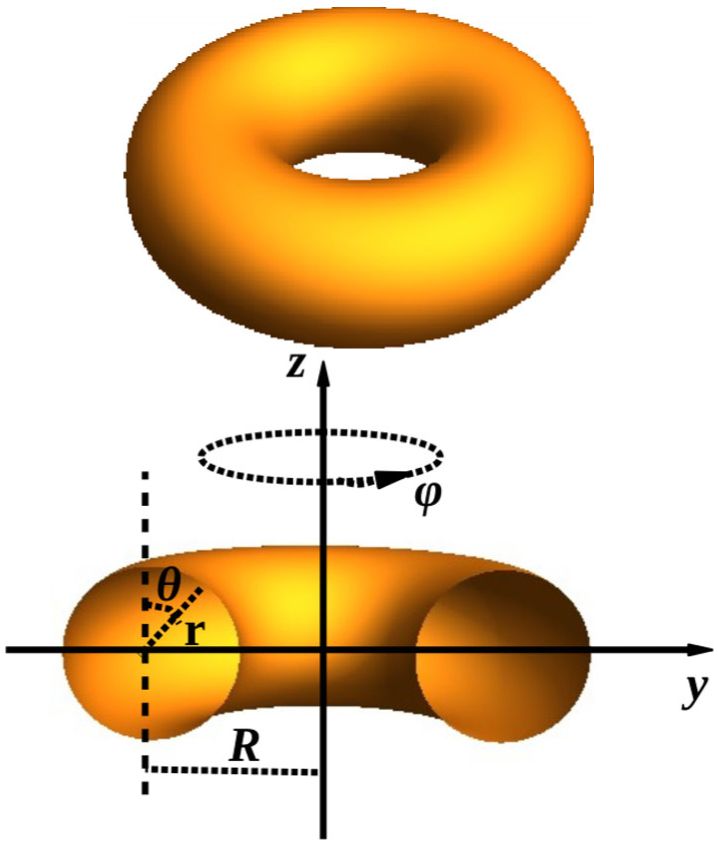
Surface phenomena in ring-shaped topological insulators are just as controllable as those in spheres made of the same material
Topological insulators behave like insulators at their core and allow good conductivity on their surface. They owe their characteristics to a new quantum state within the material discovered in 2007 and 2009 for 2D and 3D materials, respectively. Scientists studying the surface of ring-shaped, or toric, topological insulators, have just discovered some characteristics that had only previously been confirmed in spheres. Jakson Fonseca from the University Federal of Viçosa, Brazil, and colleagues describe their findings in a paper published in EPJ B. These results could hold considerable potential for applications in electronics. Indeed, this discovery means that the curved surface induces internal fields, called gauge fields, in the electrons carrying the electric charge located at the surface. By contrast, in graphene, similar fiels have been induced by mechanical tensions or defects in the way the carbon atoms are arranged in the one-atom-thick honeycomb lattice.
EPJ A Highlight - Germanium detectors get position sensitive
- Details
- Published on 21 June 2016

High purity germanium detectors have grown into the most popular devices within the field of gamma ray spectroscopy. The sensitive part of these detectors consist of the largest, purest and monocrystalline semi-conductors used on earth. In the past Ge, detectors were famous for their outstanding energy resolution and timing information for electromagnetic radiation, especially in the field of nuclear physics and nuclear astrophysics. Recently the introduction of digital data acquisition systems and the segmentation of the Ge crystals opened up new opportunities. The interaction position of the gamma rays inside the detector volume provides new additional information by means of the pulse shape of the various signals. In this way, the Ge detector becomes a position sensitive device and allows for a novel detection method called gamma-ray tracking.
EPJ D Highlight - Better material insights with gentle e-beams
- Details
- Published on 15 June 2016

Great potential for a new, more accurate, tool for using electron collisions to probe matter
There are several ways to change a molecule, chemically or physically. One way is to heat it; another is to bombard it with light particles, or photons. A lesser known method relies on electron collision, or e-beam technology, which is becoming increasingly popular in industry. In a review outlining new research avenues based on electron scattering, Michael Allan from the University of Fribourg, Switzerland and colleagues explain the subtle intricacies of the extremely brief electron-molecule encounter, in particular with gentle, i.e., very low energy electrons. In this paper, which was recently published in EPJ D, the authors describe how the use of very low energy electrons and a number of other performance criteria, make the approach with the so-called Fribourg instrument a more appealing candidate than previously available tools used to study electron collisions.
EPJ E Highlight - Versatile method yields synthetic biology building blocks
- Details
- Published on 14 June 2016
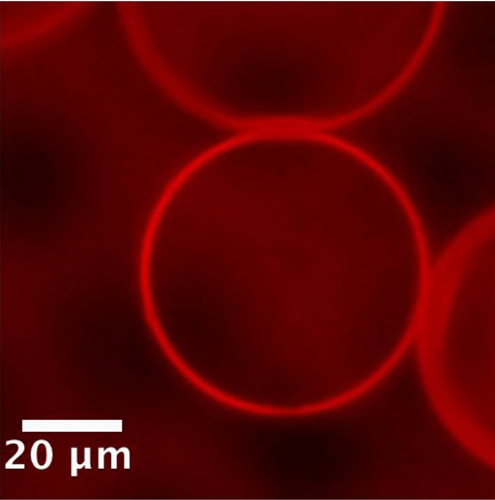
New high-throughput method to produce both liposomes and polymersomes on the same microfluidic chip
Synthetic biology involves creating artificial replica that mimic the building blocks of living systems. It aims at recreating biological phenomena in the laboratory following a bottom-up approach. Today scientists routinely create micro-compartments, so called vesicles, such as liposomes and polymersomes. Their membranes can host biochemical processes and are made of self-assembled lipids or a particular type of polymers, called block copolymers, respectively. In a new study, researchers have developed a high-throughput method--based on an approach known as microfluidics--for creating stable vesicles of controlled size. The method is novel in that it works for both liposomes and polymersomes, without having to change the design of the microfluidic device or the combination of liquids. Julien Petit from the Max Planck Institute for Dynamics and Self-Organisation (MPIDS) in Göttingen, Germany and colleagues recently published these findings in EPJ E.
EPJ Plus Highlight - Sweden’s 100% carbon-free emissions challenge
- Details
- Published on 13 June 2016

Replacing nuclear power with wind power doesn't make sense in Sweden, study shows
The Swedish power supply is largely free of carbon emissions. Indeed, it is mainly based on a combination of hydroelectric and nuclear power combined with power exchange with neighbouring Scandinavian countries. A study published in EPJ Plus investigates the possibility of replacing nuclear power with wind power, which is by nature intermittent. According to the study, this, in turn, would finally lead to a reduction in the use of hydroelectricity if the annual consumption remained constant. The authors of the study conclude that a backup system, based on fossil fuel, namely gas, would be required in combination with wind power. In such a scenario, the CO2 emissions would double. Fritz Wagner from the Max Planck Institute for Plasmaphysics, Greifswald, Germany, and Elisabeth Rachlew from the Royal Institute of Technology, Stockholm, Sweden, therefore conclude that it would not be a viable option.
EPJ D Highlight - Revisiting trajectories at the quantum scale
- Details
- Published on 07 June 2016
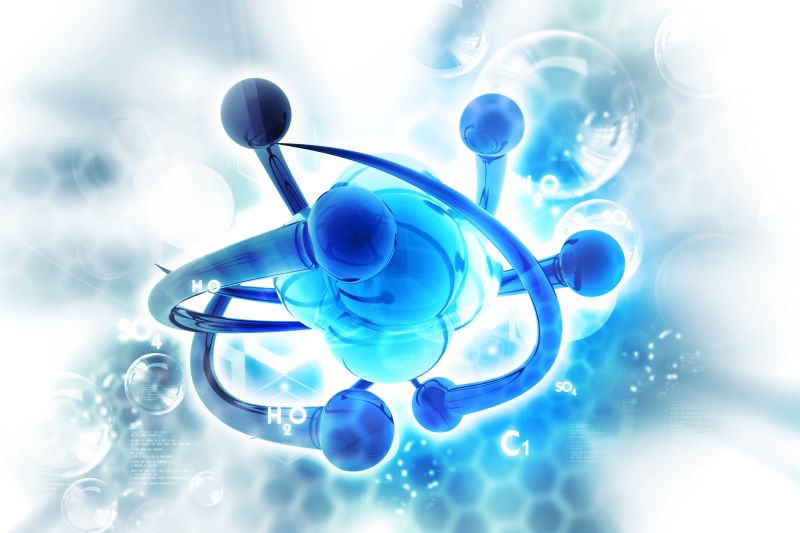
The role of statistics in quantum scale observation explains microscale behaviour
There is a gap in the theory explaining what is happening at the macroscopic scale, in the realm of our everyday lives, and at the quantum level, at microscopic scale. In this paper published in EPJ D, Holger Hofmann from the Graduate School of Advanced Sciences of Matter at Hiroshima University, Japan, reveals that the assumption that quantum particles move because they follow a precise trajectory over time has to be called into question. Instead, he claims that the notion of trajectory is a dogmatic bias inherited from our interpretation of everyday experience at the macroscopic scale. The paper shows that trajectories only emerge at the macroscopic limit, as we can neglect the complex statistics of quantum correlations in cases of low precision.
EPJ A Highlight - New approach to nuclear structure, freely available
- Details
- Published on 01 June 2016

Use of relative coordinates in nuclear structure calculations helps reduce the amount of computational power required
The atomic nucleus is highly complex. This complexity partly stems from the nuclear interactions in atomic nuclei, which induce strong correlations between the elementary particles, or nucleons, that constitute the heart of the atom. The trouble is that understanding this complexity often requires a tremendous amount of computational power. In a new study published in EPJ A, Susanna Liebig from Forschungszentrum Jülich, Germany, and colleagues propose a new approach to nuclear structure calculations. The results are freely available to the nuclear physicists’ community so that other groups can perform their own nuclear structure calculations, even if they have only limited computational resources.
EPJ E Colloquium: nanoparticles, nanorods and nanosheets at fluid interfaces
- Details
- Published on 30 May 2016
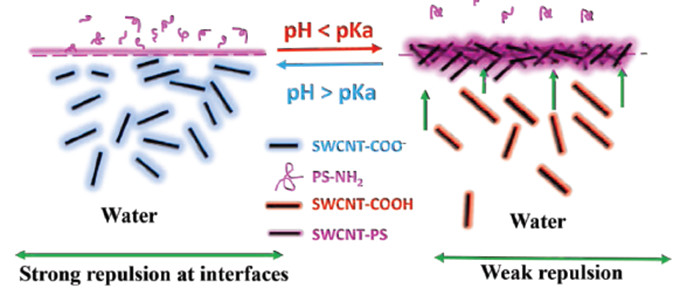
In this EPJ E Review, Toor, Feng and Russel present many examples of self-assembly of nanoscale materials (both synthetic and biological) such as nanoparticles, nanorods and nanosheets at liquid/liquid interfaces. For biological nanoparticles, the nanoparticle assembly at fluid interfaces provide a simple route for directing nanoparticles into 2-D or 3-D constructs with hierarchical ordering.
EPJ.org Mobile App available
- Details
- Published on 26 May 2016

EDP Sciences launches EPJ.org mobile app. Available and free to download from the iTunes App Store and from Google Play (for Android devices).
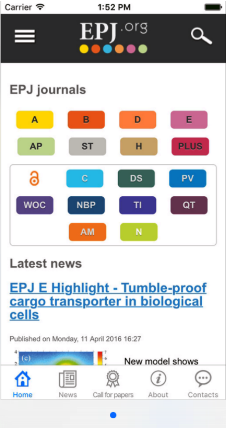
Keep up with the latest research in the physical sciences with the EPJ Journals app. The app offers a news sections with lay summaries highlighting the findings reported in selected research papers, updates on the journals contents as soon as they are published, including research papers, reviews, colloquia and proceedings papers from all European Physical Journals (http://www.epj.org). You can search to find specific papers, navigate the journals contents by issue and find out about active calls for papers.
Note: if you are accessing through a mobile device connected through your institutional VPN, you will be able to access the full text PDFs if your institution has a subscription to the journals. Some of the EPJ journals are published in Open Access so they are fully accessible to anyone, from anywhere.
Download EPJ.org App now!






